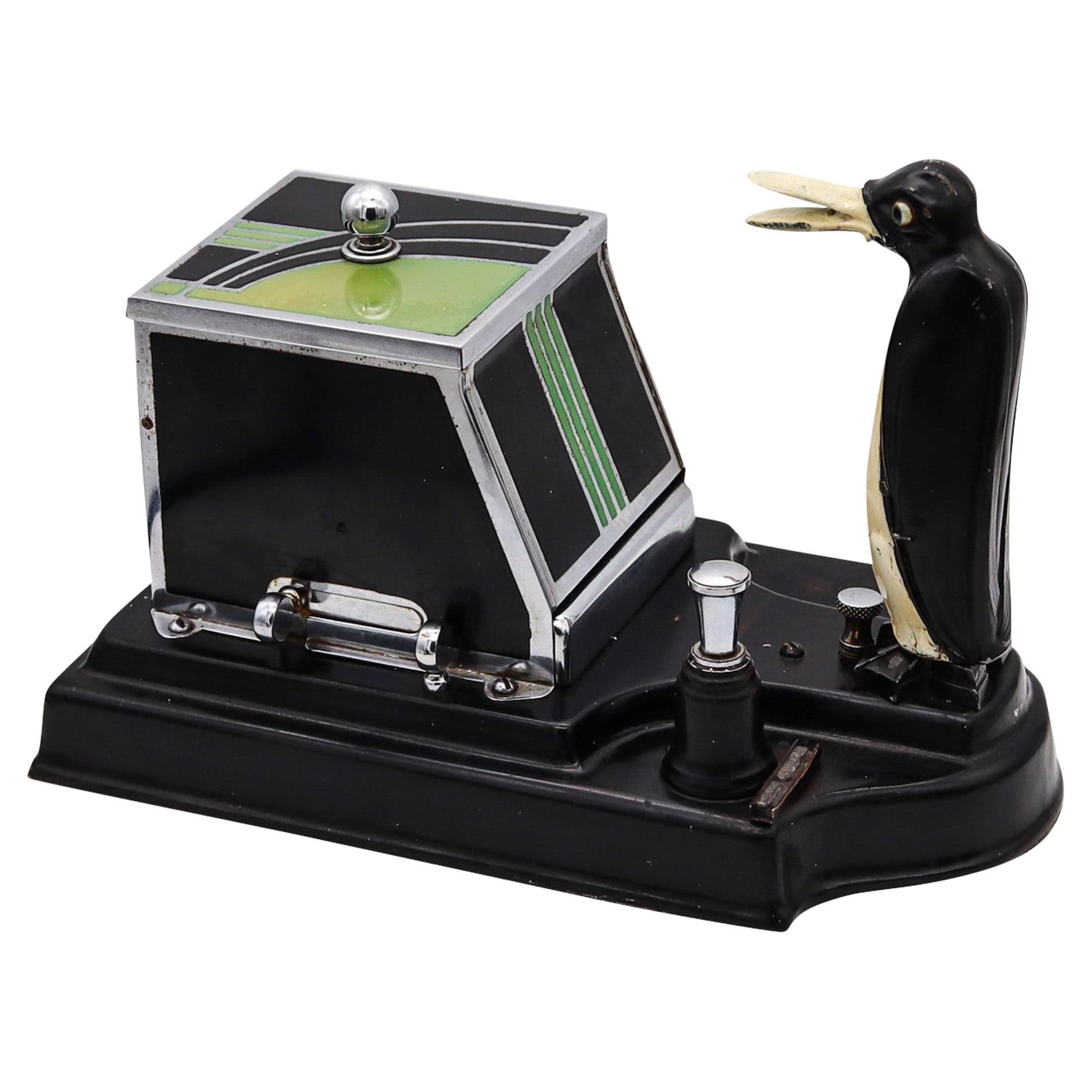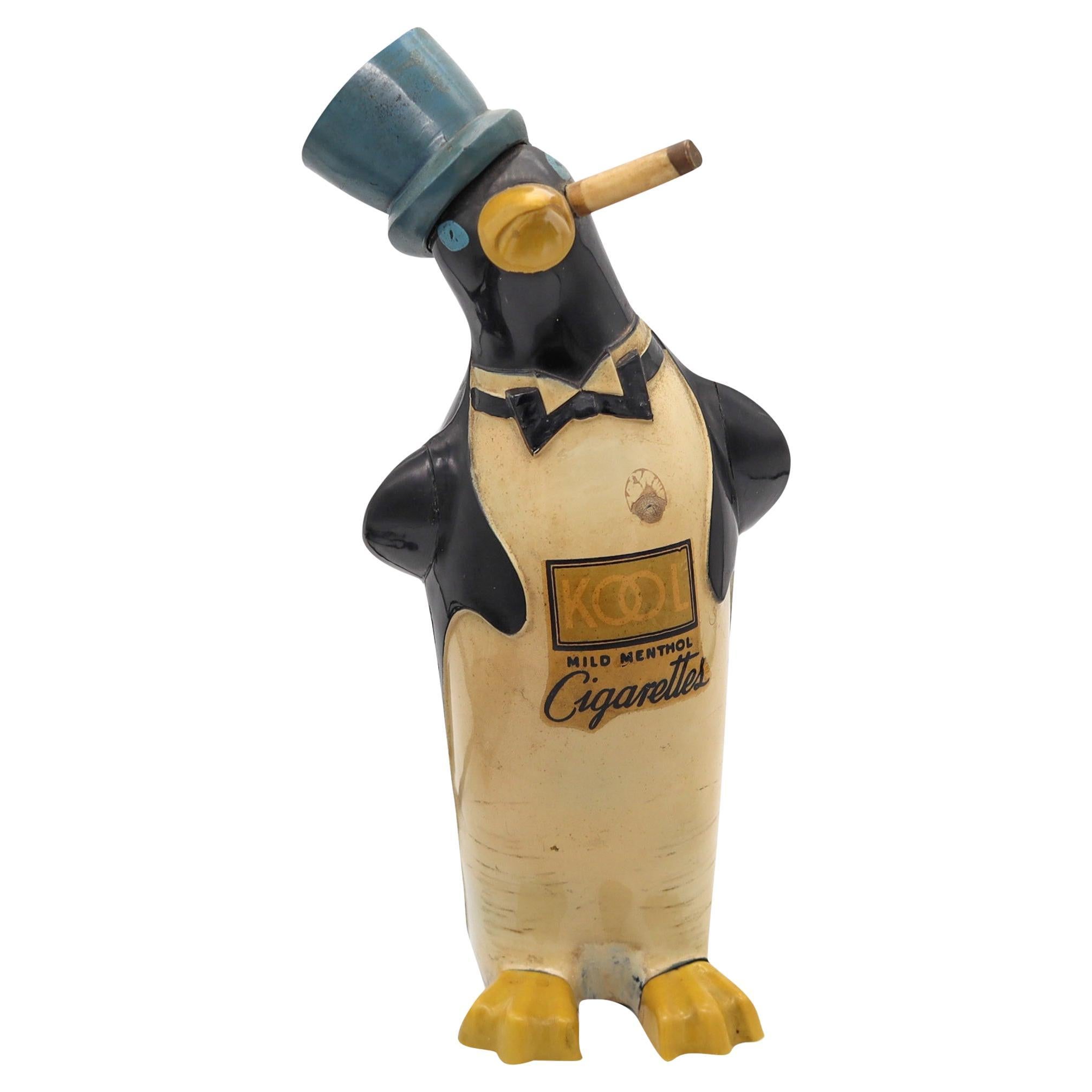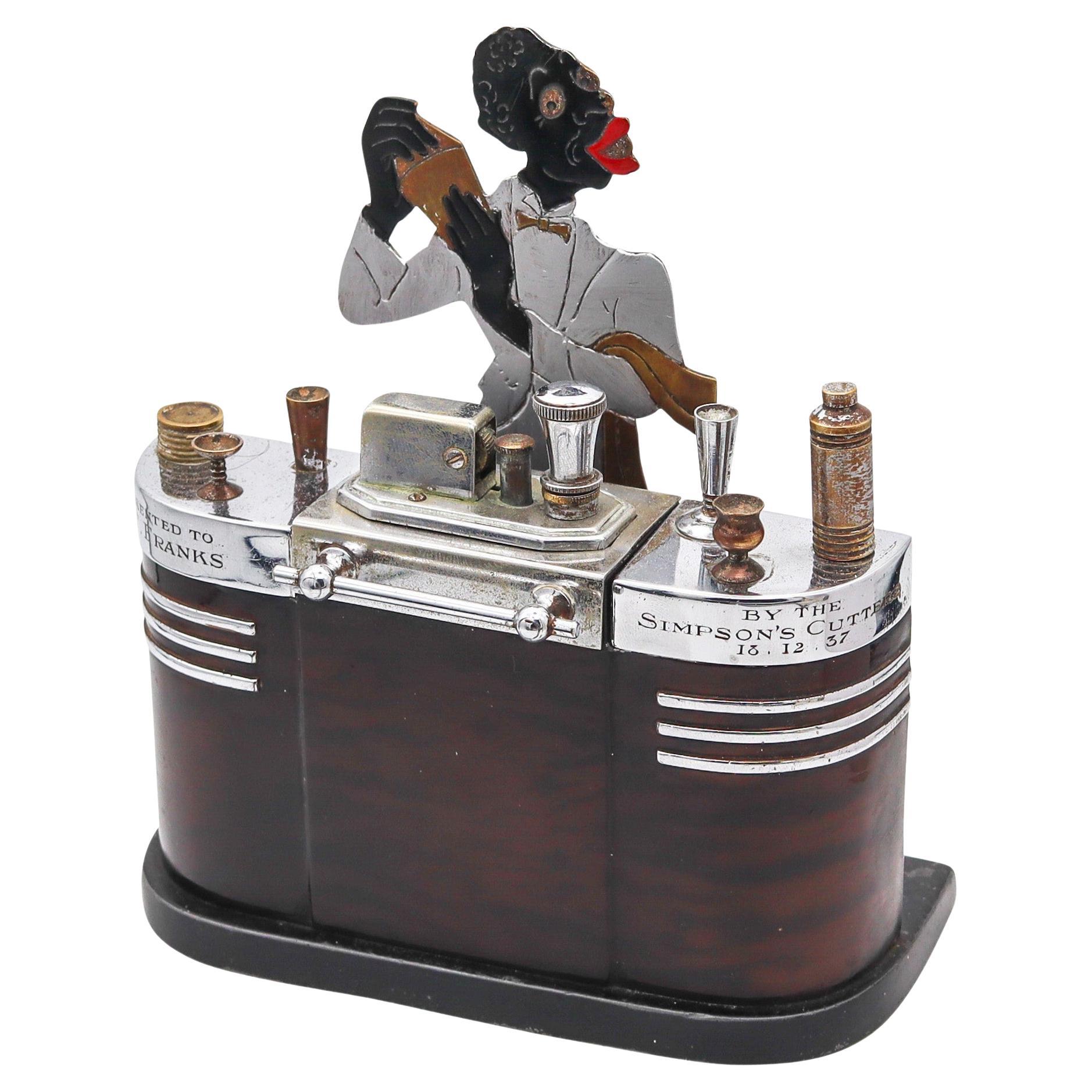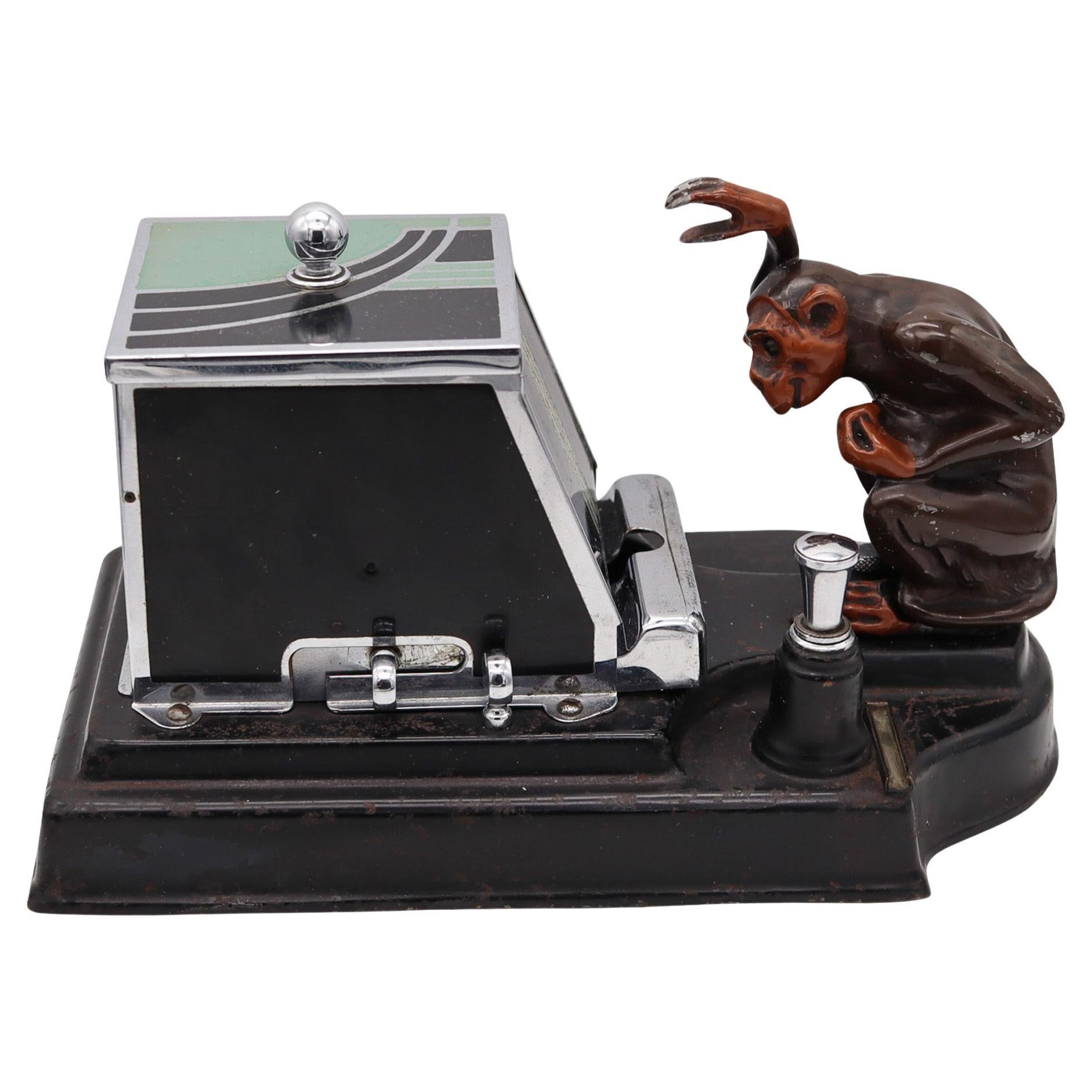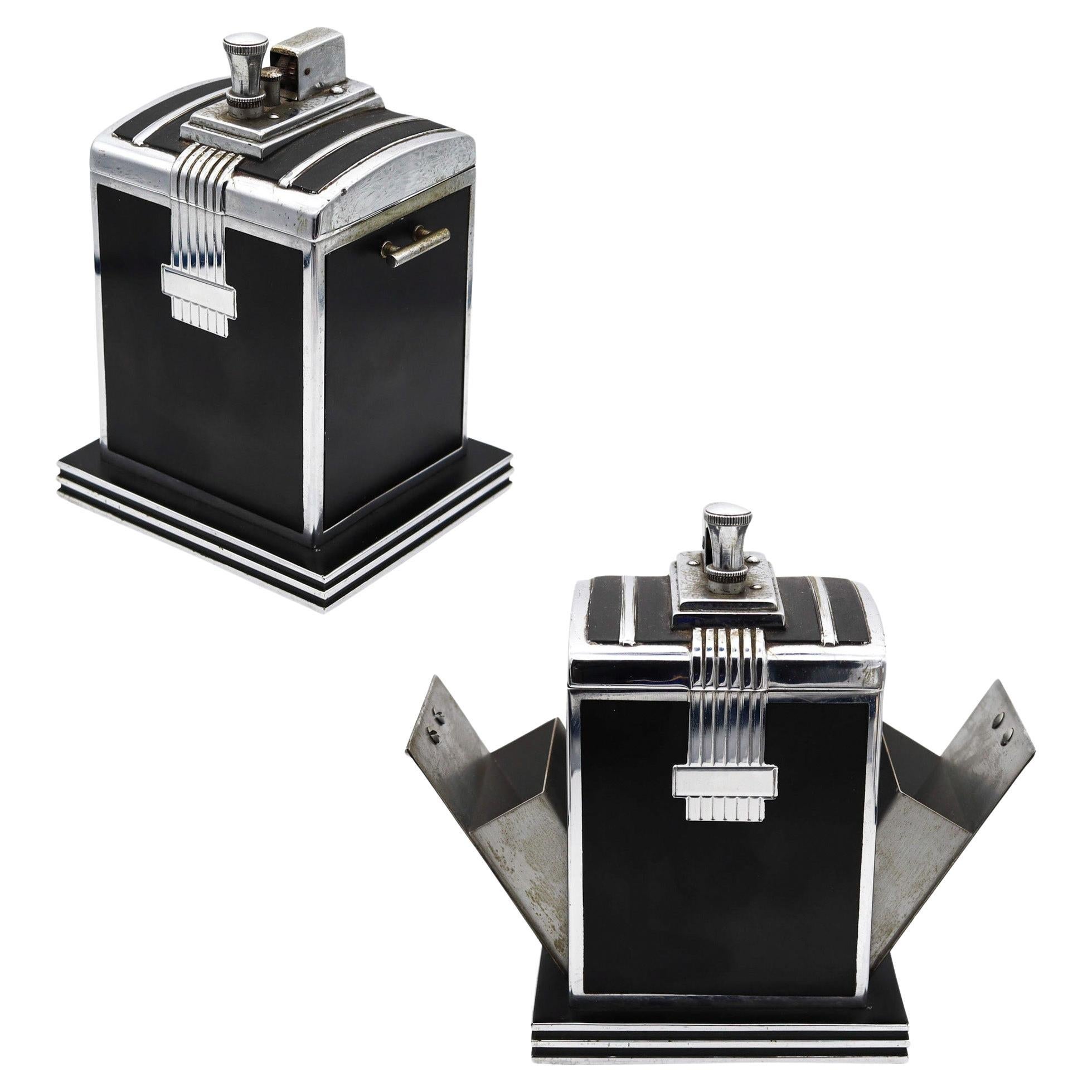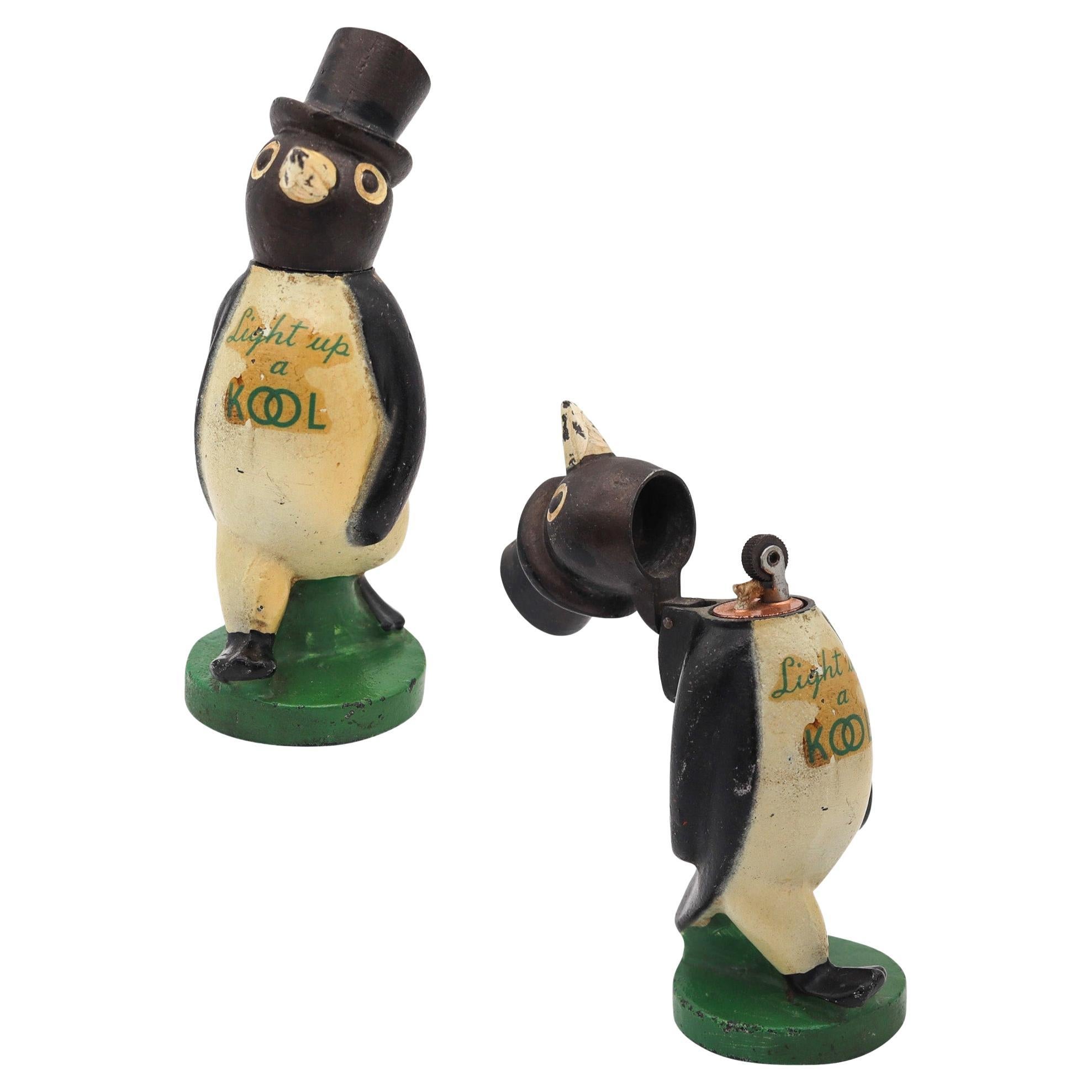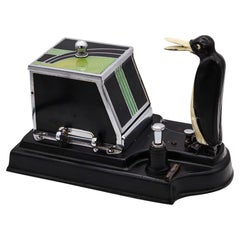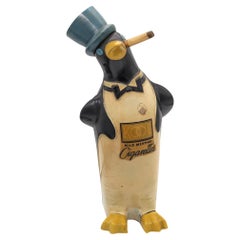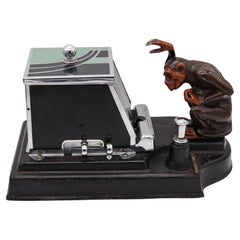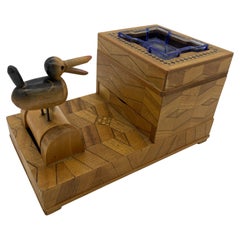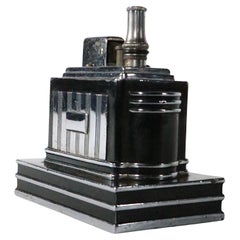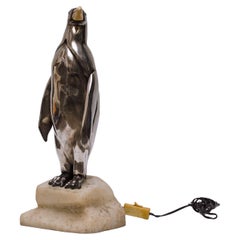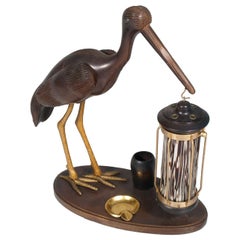Items Similar to RONSON 1930 Pik A Cig Magic Penguin Lighter Cigarette Dispenser Desk Box
Want more images or videos?
Request additional images or videos from the seller
1 of 13
RONSON 1930 Pik A Cig Magic Penguin Lighter Cigarette Dispenser Desk Box
$4,985
£3,834.79
€4,451.11
CA$7,030.04
A$7,874.83
CHF 4,136.14
MX$95,755.37
NOK 52,377.09
SEK 49,719.94
DKK 33,220.32
About the Item
Art deco magic penguin mechanical dispenser box designed by Ronson.
A beautiful, exceedingly rare and very decorative mechanical dispenser desk box, created in the city of Newark, New Jersey in the United States by The Ronson Art Metal Works Co. during the art deco period, back in the 1930. This is the iconic mechanical Pik-a-Cig Penguin Lighter box designed and patented by Louis V. Aronson with geometric and machine age patterns.
This delightful 1930 Art Deco novelty mechanical cigarette dispenser is modelled as a penguin. He is designed to move forward to pick up a cigarette in his beak when the levers at the side of the base are pushed together. This engages the mechanism, you can see how it works in the video in the listing. The cigarette container section has a very stylish Art Deco design treated with textures and bronze color The bottom of the base is paint in red.
It was crafted with parts made up in solid bronze for the penguin and patinated textured brass for the rest. It is embellished with a ball knob to lid on gunmetal base with black and white lacquer enamel, creating a great contrast and the interiors are finished with round brushed Florentine brushed circular patterns. All is mounted in a rectangular base marbleized with black and white paint.
The slide action mechanism reveals a tray with recess, penguin's beak to pick up the cigarette. It is extremely well made with a solid construction and with very nice care and attention to all details. This surely is a very decorative collector’s piece and a great conversation item.
Condition and preservation: Almost in near mint condition, 8/10, with no traces of abuse.
Rarity: Extremely rare.
Materials: Steel, lacquer, paint and bronze.
Weight: 1,588 Grams, (3.5 Pounds).
Measurements: 20.07 cm x 12.77 cm x 14.22 cm (7.9 x 5 x 5.6 Inches).
Designer: Louis Vincent Aronson.
Manufacturer: Ronson Art Metal Works Inc. Newark NJ USA.
Patent: Louis V. Aronson, 1930-1935 Dispensing Mechanism Pat.
The Ronson Lighter Company
The company started as The Art Metal Works in 1897 and was incorporated on July 20, 1898, by Max Hecht, Louis Vincent Aronson and Leopold Herzig, in Newark, New Jersey. Louis V. Aronson was a huge creative driving force for the company; and, with a few business adjustments, including the addition of Alexander Harris (1910–11) as Business Manager, the company soon became World Famous. In the 1910s The Art Metal Works were producing very good quality Hood Ornaments and gained a reputation as a dependable supplier of same. All accounts state that Louis Aronson was a gifted man, who at 16 years old set up a money-making shop in his parent's home - before receiving a U.S. patent for a commercially valuable metal-plating process he developed when he was 24 years old, and he sold half the rights while retaining the Right to Use. "His experiments, which he has been conducting since his early youth, resulted in 1893 in the discovery of a process for electrically producing tinplate. Much money was expended upon improving the process... and has been of great practical value to the whole industry. Retaining its rights, he sold half the patent rights, and later used part of the proceeds to open the Art Metal Works in Newark, N.J. Soon the company was producing a variety of high-quality Lamps, Book ends, Art Statues and other decorative items, prized today for their detail in the collector marketplace.
Courtesy: The Lighter Library
Louis Vincent Aronson
Louis Vincent Aronson was an American inventor, industrialist and philanthropist who is best remembered as the inventor of Ronson lighters. "He was a son of Simon and Jennie Aronson, who were natives of Prussia. He was born December 25, 1869, in New York City, and there his boyhood was spent. Aronson was an exceptionally gifted young man who graduated from public school at the age of 12 before entering a New York Technical School specializing in metallurgy, practical metal working and mechanical drawing. At the same time, he set up a laboratory in the basement of his parents' home where he experimented with plating processes and turned-out money-making items while he devised ways of metalizing common items, in a durable finish of matte gold, including flowers, butterflies, animal claws and baby shoes. Aronson natural ability for designing was honed at the technical school and served him well throughout his life. He excelled and completed the school’s four-year academic program in three years. When he graduated in 1886, at the age of 16, he was qualified as an Expert Metallurgist, Draftsman and Designer, he also had a high-level knowledge of Chemistry. He returned to the school five years later as an instructor in metallurgy for several years before devoting all his time to his own company. When he was 24 years old, he sold the rights to a commercially valuable metal plating process according to Urban Cummings book Ronson, The World’s Greatest Lighters, Wick Lighters 1913–2000. He gained public recognition when he won an award in 1893 from the Belgian government for the creation of the first non-toxic match, and young businessman Aronson received 50,000 Francs, equaling $10,000 in U.S. dollars. In 1897 he received a U.S. patent (592,227) for a match design (called the Wind-match) that would light in windy conditions or when wet. He continued working on his match designs including inventing the “Birds Eye” or “Kitchen” match that had a dual-tip design in 1903; this was an important safety improvement because friction matches of the day would sometimes light accidentally especially when stepped on or while in one’s pocket. He realized that placing a small friction ignition chemical on the tip instead of the entire match-head greatly limited accidental ignition. This style of match is still in use today.
Literature: Urban K. Cummings, Ronson, the World's Greatest Lighter: Wick Lighters 1913-1966 Bird Dog Books, California. 1992. Pp-248 for this exact mode illustrated, see figure 248.
Note: This model was produced in several colors combination and finishes. Corresponding to the company's model 13184, they were originally retailed back in time, between 10.00 and 20.85 dollars.
Note: This piece and the lighter are empty of any flammable, gas or butane substances and is ready to be ship by any carrier.
Condition: The overall condition of this Ronson Penguin piece is excellent. Beside the little normal wear, there is in superb condition with no damage, barely used. This piece has been carefully inspected to guarantee the condition, authenticity and all parts are properly working.
INVENTORY REF: D032825XIAE/.7865
- Creator:Louis Vincent Aronson (Designer),Ronson Art Metal Works (Manufacturer)
- Dimensions:Height: 5.6 in (14.23 cm)Width: 7.9 in (20.07 cm)Depth: 5 in (12.7 cm)
- Style:Art Deco (Of the Period)
- Materials and Techniques:
- Place of Origin:
- Period:
- Date of Manufacture:1930
- Condition:Wear consistent with age and use. The overall condition of this Ronson Penguin piece is excellent. Beside the little normal wear, there is in superb condition with no damage, barely used. This piece has been carefully inspected to guarantee the condition, authenticity and all parts.
- Seller Location:Miami, FL
- Reference Number:Seller: D032825XIAE/.78651stDibs: LU8303244612072
About the Seller
5.0
Gold Seller
Premium sellers maintaining a 4.3+ rating and 24-hour response times
1stDibs seller since 2023
206 sales on 1stDibs
Typical response time: 3 hours
- ShippingRetrieving quote...Shipping from: Miami, FL
- Return Policy
Authenticity Guarantee
In the unlikely event there’s an issue with an item’s authenticity, contact us within 1 year for a full refund. DetailsMoney-Back Guarantee
If your item is not as described, is damaged in transit, or does not arrive, contact us within 7 days for a full refund. Details24-Hour Cancellation
You have a 24-hour grace period in which to reconsider your purchase, with no questions asked.Vetted Professional Sellers
Our world-class sellers must adhere to strict standards for service and quality, maintaining the integrity of our listings.Price-Match Guarantee
If you find that a seller listed the same item for a lower price elsewhere, we’ll match it.Trusted Global Delivery
Our best-in-class carrier network provides specialized shipping options worldwide, including custom delivery.More From This Seller
View AllRonson 1930 Pik a Cig Magic Penguin Touch Tip Cigarette Dispenser Desk Box
By Ronson Art Metal Works, Louis Vincent Aronson
Located in Miami, FL
Art deco magic penguin mechanical dispenser box designed by Ronson.
A beautiful, exceedingly rare and very decorative mechanical dispenser desk box, created in the city of Newark, N...
Category
Vintage 1930s North American Art Deco Tobacco Accessories
Materials
Bronze, Steel
$4,680 Sale Price
20% Off
WILLIE KOOL 1938 The Penguin Figural Bar And Table-Desk Electric Lighter
Located in Miami, FL
Willie Kool desk-table electric lighter.
This is a beautiful electronic bar or desk lighter, created as a promotional item by the Kool Cigarette Company, back in the 1938. The sculptural and elusive electric lighter has been crafted with the iconic figure of the company Willie Kool, in color plastic with parts in metal and fitted with a long electric cord. The figural penguin is in pretty very good shape, in working condition and should be a gorgeous addition to any collection. This will be a great conversation item.
Willie The Penguin
Willie the penguin was introduced in 1934 by The Ted Bates Advertising Agency. During the time there were several other cartoonish spokespersons like Kellog’s Snap, Crackle & Pop, Reddy Kilowatt, and the Campbell’s Kids. Willie’s product line included salt and pepper shakers, ash trays, holders for wooden matches, lighters, and when air-conditioning was introduced, a version was created to suggest customers to enter a storefront because it was “Kool” inside. It has also been debated that a picture of Willie wearing a top hat was the inspiration for the Penguin character in Batman. Regardless, Willie appeared in his own comic books after he was licensed by Standard Comics for six issues, with the cigarette brand dropped from the title. By the ’60s, however, the company had shifted advertising focus and opted for wintry outdoor scenes to promote their business. (Miller Fenwood with thanks)
Materials: Lacquered and color plastic, metal, electric cord and enamel.
Year: 1934-1940.
Weight: 1.5 Pounds, (0.68 Kg.).
Measurements: 89 mm by 114 mm by 223 mm (3.5 x 4.25 x 8.75 Inches).
Marks: "KOOL MILD MENTHOL CIGARETTES".
Note: This lighter is empty of any flammable, gas or butane substances and is ready to be ship by any carrier. This lighter just need a new flint and proper lighter fluid. Was tested and is in working condition.
Note: This is an electric novelty advertising lighter, is a very old vintage Tobacciana...
Category
Vintage 1930s American Art Deco Tobacco Accessories
Materials
Steel
RONSON 1935 Art Deco Bartender Lighter Cigarette Dispenser Box In Steel & Lcquer
By Louis Vincent Aronson, Ronson Art Metal Works
Located in Miami, FL
Barman dispenser box with lighter designed by Ronson.
An exceptional and very beautiful desk piece, created in New Jersey United States by The Ronson Lighter Co. during the art deco...
Category
Vintage 1930s American Art Deco Tobacco Accessories
Materials
Steel
Ronson 1936 Pik a Cig Magic Monkey Striker Touch Lighter & Cigarette Dispenser
By Ronson Art Metal Works, Louis Vincent Aronson
Located in Miami, FL
Art deco magic monkey mechanical dispenser box designed by Ronson.
An extremely rare and very decorative mechanical desk box, created in the city of Newark, New Jersey United States by The Ronson Metal Works Co. during the art deco period, back in the 1936. This is the mechanical Pik-a-Cig Monkey box...
Category
Vintage 1930s American Art Deco Cigar Boxes and Humidors
Materials
Bronze, Enamel, Steel
$3,188 Sale Price
20% Off
RONSON 1937 Art Deco T-T Smoker's Desk Double Box & Touch Tip Lighter
By Ronson Art Metal Works, Ronson
Located in Miami, FL
T-T Smoker's desk box with lighter made by Ronson.
This desk box for cigarettes is exceptional and very rare. Has been created in the city of Newark, New Jersey United States by The...
Category
Vintage 1930s American Art Deco Tobacco Accessories
Materials
Enamel, Steel, Chrome
WILLIE KOOL 1938 The Penguin Figural Bar And Table-Desk Petrol Lighter
Located in Miami, FL
Willie Kool desk-table petrol lighter.
This is a beautiful bar or desk petrol lighter, created as a promotional item by the Kool Cigarette Company, back in the 1938. The sculptural and elusive lighter has been crafted with the iconic figure of the company Willie Kool, in solid steel and decorated with green, black and white paint. The figural penguin is in pretty very good shape, in working condition and should be a gorgeous addition to any collection. This will be a great conversation item.
Willie The Penguin
Willie the penguin was introduced in 1934 by The Ted Bates Advertising Agency. During the time there were several other cartoonish spokespersons like Kellogg’s Snap, Crackle & Pop, Reddy Kilowatt, and the Campbell’s Kids. Willie’s product line included salt and pepper shakers, ash trays...
Category
Vintage 1930s American Art Deco Tobacco Accessories
Materials
Steel, Enamel
You May Also Like
Vintage Inlay Carved Wood Cigarette Box Holder Dispenser with Ashtray and Mechan
Located in Van Nuys, CA
Vintage wooden cigarette box, cigarette holder, and ashtray with mechanical bird. simply push down the lever and a cigarette will be dispe...
Category
Vintage 1930s American Art Deco Tobacco Accessories
Materials
Wood
$379 Sale Price
30% Off
Art Deco Machine Age Ronson Deluxe Touch Tip Table Lighter c. 1930's
By Louis Vincent Aronson, Ronson
Located in New York, NY
Classic Art Deco Machine Age table top cigarette lighter, by Ronson. This rare model was designed by Louis Vincent Aronson, made by Ronson Art Metal Works Inc.. Known as a Touch Tip...
Category
Vintage 1930s American Art Deco Tobacco Accessories
Materials
Metal, Chrome
Penguin iluminated sculpture by Marcel André Bouraine
By Marcel-André Bouraine
Located in Ciudad Autónoma Buenos Aires, C
Penguin iluminated sculpture by Marcel André Bouraine (1886 -1948). Silverplated bronze and alabaster base with light.
Bryan Catley (1978) "Art Deco ...
Category
Vintage 1920s French Art Deco Table Lamps
Materials
Alabaster, Bronze
1940s Art Deco Heron Table Lamp, by Aldo Tura, Ashtray, Cigarette Service
By Bassano's Ebanisteria
Located in Vigonza, Padua
Italian midcentury Art Deco style table lamp, ashtray, cigarette service or centre table, by Aldo Tura , in hand carved wood, with metal fusion parts. Parchment lampshade. Working el...
Category
Vintage 1930s Italian Art Deco Table Lamps
Materials
Beech, Walnut
Vintage Silver Plated Penguin Paperweight Shelf Decor
Located in North Hollywood, CA
Vintage art deco revival style silver plated heavy penguin paperweight.
In very good vintage preowned condition, the penguin is bright and well made and shows minimal signs of wear.
...
Category
1990s American Paperweights
Materials
Metal
"Alfred the Penguin" Bronze, Art Deco Figurine on Portoro Marble, France, 1930
Located in Bochum, NRW
Alfred the Penguin – Art Deco Figurine
An enigmatic and elegantly sculpted penguin, this piece pays homage to Alfred, the iconic silent companion fro...
Category
Vintage 1920s French Art Deco Animal Sculptures
Materials
Marble, Bronze, Nickel
